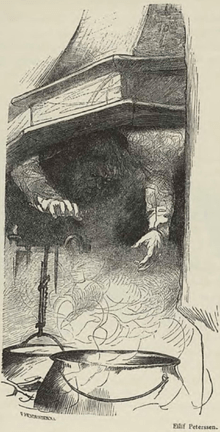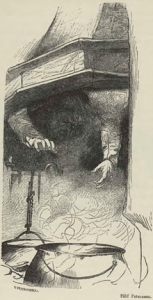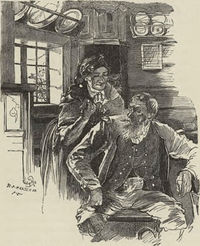
 Once upon a time there was a man who was so bad tempered because he thought his wife never did anything right in the house. One evening, during haymaking season, he came home, scolding and swearing, showing his teeth and making commotion. “Dear love, don’t be so angry” said his wife, ” let’s swap jobs tomorrow. I’ll go out with the mowers and mow, and you can mind the house”
Once upon a time there was a man who was so bad tempered because he thought his wife never did anything right in the house. One evening, during haymaking season, he came home, scolding and swearing, showing his teeth and making commotion. “Dear love, don’t be so angry” said his wife, ” let’s swap jobs tomorrow. I’ll go out with the mowers and mow, and you can mind the house” First of all he wanted to churn the butter. But when he had churned for a while, he got thirsty and went down to the cellar to tap a barrel of ale. He had just knocked in the bung and was putting in the tap, when he heard the pig come into the kitchen above. As fast as he could, he ran up the cellar steps, with the tap in his hand, to keep the pig from upsetting the churn. But when he got there he saw that the pig had already knocked over the churn and was standing there routing and grunting in the cream which was running all over the floor. He got so angry that he quite forgot the ale barrel and ran at the pig as hard as he could. He caught it just as it ran out of the door and gave it such a powerful kick that he killed it on the spot. Then he remembered he had the tap in his hand. But when he returned to the cellar, all the ale had run out of the barrel. Then he went into the milk-shed and found enough cream left to fill the churn again, and so he began to churn, for they had to have butter for dinner.
When he had churned a bit, he remembered that their milk cow was still locked in the barn and hadn’t had a bit to eat or a drop to drink all morning, although the sun was up high already. It occurred to him that it was too far to take her down to the meadow, so he would just get her up onto the roof, for it was a sod roof, and a fine crop of grass was growing there. The house was close against a steep hill, and he thought if he could put a plank across to the back of the roof, he would easily get the cow up.
But he couldn’t leave the churn, for his little baby was there crawling on the floor. “If I leave it,” he thought, “the child will tip it over.” So he put the churn on his back, and went out with it. But then he thought he’d better first water the cow before he would put her on the roof, so he picked up a bucket to draw water out of the well. But as he stooped over the edge of the well all the cream ran out of the churn over his shoulder and went down the well.
Now it was nearly dinner time, and he hadn’t even finished the butter yet, so he thought he’d best boil the porridge. He filled the pot with water and hung it over the fire. When he had done that, it occurred to him that the cow might fall off the roof and break her legs or her neck, so he climbed up onto the house to tie her up. He tied one end of the rope around the cow’s neck. He slipped the other end down the chimney and tied it around his own leg. Then he had to hurry, for the water was now boiling in the pot, and he still had to grind the oatmeal.
He began to grind away; but while he was hard at it, the cow fell off the roof, dragging the man up the chimney by the rope. There he got stuck. As for the cow, she hung halfway down the wall, swinging between heaven and earth, for she could neither get down nor up.
Now the wife waited seven lengths and seven breaths for her husband to come and call her home to have dinner, but he never came. At last she thought she’d waited long enough, and she went home. But when she arrived home and saw the cow hanging there, she ran up and cut the rope with her scythe. When she did this, her husband fell down inside the chimney. When the old woman came inside, she found him with his head in the porridge pot.
Translation revised by D. L. Ashliman. © 2001.




